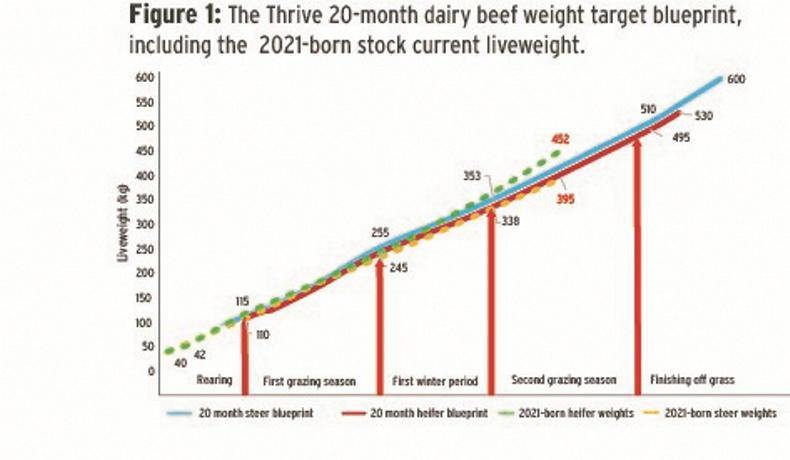On the Thrive demonstration farm in Cashel, Co Tipperary, the 145 yearling cattle are now at grass almost three months. Looking back to housing time, with decent weather conditions and favourable grass growth, calves were held out at grass for an extra three weeks into early-December. However, performance during this period was quite poor, which led to calves being about 10kg below target weight at housing.
Over the winter months, performance was good on a diet of 70% dry matter digestibility (DMD) silage plus 2kg/day concentrate and perhaps cattle compensated slightly for the poorer performance late season at grass.
Meal feeding was stopped three weeks prior to turnout in spring. Average daily gain over the winter period was 0.80kg/day for the heifers and 0.93kg/day for the bullocks. The aim for this year is to make higher quality silage so meal feeding can be reduced over the winter months.
Since turnout on 1 March, the bullocks have continued to outperform the heifers quite considerably, with an average daily gain of 0.90/day for the heifers and 1.02kg/day for the bullocks.
It means as of 11 May, the heifers averaged 395kg, about 5kg below target, while the bullocks were 452kg, almost 30kg ahead of target for the time of year. Figure 1 shows the target weights for bullocks (blue) and heifers (red) in a 20-month production system. The yellow and green lines are the current yearling bullocks and heifers.
Table 1 looks at the current weights on a breed basis and shows the average daily gain of stock since turnout.
Why the bullocks have outperformed the heifers to such an extent is not clear – they were offered the same winter diet and since going to grass, both the heifers and bullocks have been offered high-quality pasture, entering pre-grazing covers of between 1,400kg DM/ha and 1,600kg DM/ha consistently.
The aim for the coming weeks with these cattle is to try to maintain grazing quality. At this stage, 32% of the grazing platform has been taken out as surplus bales yielding 138 bales or 6.5 bales/ac. While this is expensive silage to make, it will be of the highest quality for growing stock during the winter.
More importantly, it will help maintain grass quality and therefore growth performance of cattle at grass over the coming weeks.
Feeding meal to calves at grass
While yearling cattle are on a grass-only diet for the grazing season, whether or not this year’s calves should be fed meal at grass always sparks discussion among farmers.
The majority of the Thrive programme farmers have fed 1kg/day concentrate to calves throughout the first grazing season over the last few years, mainly for the reason that they are trying to have animals fit for slaughter at the end of the second grazing season, and in order to do so, stock need to be performing every day they are on the farm.
Once calves are settled at pasture and where grass quality is good and grazing conditions are favourable, some will cut out meal feeding in mid-June for six weeks or so before reintroducing meal in the autumn. The programme farmers are finding that by feeding 1kg/day at grass for the first season, it ensures calves are on target at housing time.
This year more than ever, having calves on target coming into winter is going to be really important. While concentrate prices are high currently, all indications point towards even higher meal prices this winter.

Therefore, if feeding 1kg/day now will save having to feed higher concentrate rates next winter, then it could be a good investment. However, meal feeding at grass should never be done to compensate for poor grassland management. Calves should be offered fresh pasture at least once a week.
Fibre in the calf diet
Calves grazing lush pasture will have very little fibre in their diet. In recent years, there have been reports of increased instances of summer scour in calves at grass.
Often this is where grass is lush and highly digestible, with little or no fibre present and is more common in periods of poor weather when grass dry matter is low.
Calves go from eating straw and meal indoors to lush grass outdoors, which is a huge change in the diet in a short period of time.
On the Thrive demonstration farm, the oldest batches of calves are now weaned and at grass full-time. They are receiving 1kg/day concentrate and have access to a feeder with straw for fibre.
Calves will self-regulate when it comes to straw intake. In periods of wet weather, it is noticeable how much more straw calves will eat to keep their diet balanced.
Where summer scour has been an issue on farms in the past, keeping straw with calves, as well as offering a nut that is high in digestible fibres such as beet pulp or soya hulls, can be beneficial.
Some rations will also have an acid buffer included, which can help prevent issues with summer scour.






 This is a subscriber-only article
This is a subscriber-only article










SHARING OPTIONS: